| Listing 1 - 10 of 12 | << page >> |
Sort by
|
Book
Year: 1993 Publisher: Princeton, N. J. Princeton University Press
Abstract | Keywords | Export | Availability | Bookmark
 Loading...
Loading...Choose an application
- Reference Manager
- EndNote
- RefWorks (Direct export to RefWorks)
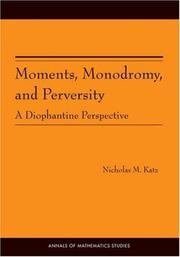
ISBN: 0691123306 Year: 2005 Publisher: Princeton Princeton University Press
Abstract | Keywords | Export | Availability | Bookmark
 Loading...
Loading...Choose an application
- Reference Manager
- EndNote
- RefWorks (Direct export to RefWorks)
L-functions --- Monodromy groups --- Sheaf theory
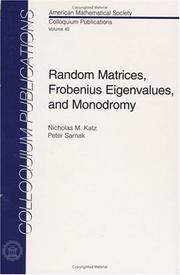
ISSN: 00659258 ISBN: 0821810170 9780821810170 Year: 1999 Volume: 45 Publisher: Providence, R.I. American Mathematical Society
Abstract | Keywords | Export | Availability | Bookmark
 Loading...
Loading...Choose an application
- Reference Manager
- EndNote
- RefWorks (Direct export to RefWorks)
Functions, Zeta. --- L-functions. --- Random matrices. --- Limit theorems (Probability theory) --- Monodromy groups. --- Group theory --- Probabilities --- Matrices, Random --- Matrices --- Functions, L --- -Number theory --- Zeta functions --- Functions, Zeta --- L-functions --- Monodromy groups --- Random matrices
Book
ISBN: 3540186867 0387186867 3540480722 9783540186861 Year: 1987 Volume: 1293 Publisher: Berlin: Springer,
Abstract | Keywords | Export | Availability | Bookmark
 Loading...
Loading...Choose an application
- Reference Manager
- EndNote
- RefWorks (Direct export to RefWorks)
Algebraic geometry --- 512.54 --- Groups. Group theory --- Intersection theory. --- Monodromy groups. --- Singularities (Mathematics) --- Singularities (Mathematics). --- 512.54 Groups. Group theory

ISBN: 9780821839928 Year: 2007 Publisher: Providence American Mathematical Society
Abstract | Keywords | Export | Availability | Bookmark
 Loading...
Loading...Choose an application
- Reference Manager
- EndNote
- RefWorks (Direct export to RefWorks)
Differential geometry. Global analysis --- 51 <082.1> --- Mathematics--Series --- Permutation groups. --- Curves. --- Monodromy groups. --- Riemann surfaces. --- Symmetry groups. --- Groupes de permutations. --- Courbes. --- Groupes de monodromie. --- Riemann, Surfaces de. --- Groupes de symétrie. --- Curves --- Monodromy groups --- Permutation groups --- Riemann surfaces --- Symmetry groups --- Groups, Symmetry --- Symmetric groups --- Crystallography, Mathematical --- Quantum theory --- Representations of groups --- Surfaces, Riemann --- Functions --- Substitution groups --- Group theory --- Calculus --- Conic sections --- Geometry, Analytic --- Geometry, Differential --- Geometry, Enumerative --- Mathematics --- Shapes
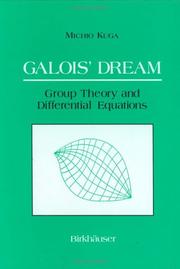
ISBN: 0817636889 3764336889 1461203295 9780817636883 Year: 1993 Publisher: Boston Birkhäuser
Abstract | Keywords | Export | Availability | Bookmark
 Loading...
Loading...Choose an application
- Reference Manager
- EndNote
- RefWorks (Direct export to RefWorks)
Monodromy groups --- Galois theory --- Differential equations --- 517.91 --- #KVIV:BB --- Group theory --- Equations, Theory of --- Number theory --- Equations, Differential --- Bessel functions --- Calculus --- Ordinary differential equations: general theory --- Differential equations. --- Galois theory. --- Monodromy groups. --- 517.91 Differential equations --- 517.91 Ordinary differential equations: general theory --- 517.91. --- Numerical solutions --- Groupes, Théorie des --- Groupes, Théorie des --- Galois, Théorie de --- Equations differentielles dans le domaine complexe --- Geometrie algebrique --- Varietes algebriques
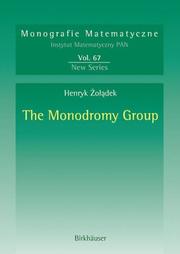
ISBN: 1280615710 9786610615711 3764375361 3764375353 Year: 2006 Publisher: Boston : Birkhauser,
Abstract | Keywords | Export | Availability | Bookmark
 Loading...
Loading...Choose an application
- Reference Manager
- EndNote
- RefWorks (Direct export to RefWorks)
In singularity theory and algebraic geometry the monodromy group is embodied in the Picard-Lefschetz formula and the Picard-Fuchs equations. It has applications in the weakened 16th Hilbert problem and in mixed Hodge structures. In the theory of systems of linear differential equations one has the Riemann-Hilbert problem, the Stokes phenomena and the hypergeometric functions with their multidimensional generalizations. In the theory of homomorphic foliations there appear the Ecalle-Voronin-Martinet-Ramis moduli. On the other hand, there is a deep connection of monodromy theory with Galois theory of differential equations and algebraic functions. All this is presented in this book, underlining the unifying role of the monodromy group. The material is addressed to a wide audience, ranging from specialists in the theory of ordinary differential equations to algebraic geometers. The book contains a lot of results which are usually spread in many sources. Readers can quickly get introduced to modern and vital mathematical theories, such as singularity theory, analytic theory of ordinary differential equations, holomorphic foliations, Galois theory, and parts of algebraic geometry, without searching in vast literature.
Monodromy groups. --- Riemann-Hilbert problems. --- Hilbert-Riemann problems --- Riemann problems --- Boundary value problems --- Group theory --- Algebra. --- Algebraic topology. --- Functions of complex variables. --- Differential Equations. --- Functions, special. --- Algebraic Topology. --- Functions of a Complex Variable. --- Ordinary Differential Equations. --- Special Functions. --- Special functions --- Mathematical analysis --- 517.91 Differential equations --- Differential equations --- Complex variables --- Elliptic functions --- Functions of real variables --- Topology --- Mathematics --- Differential equations. --- Special functions.
Book
ISBN: 9781470418410 Year: 2016 Publisher: Providence : American Mathematical Society,
Abstract | Keywords | Export | Availability | Bookmark
 Loading...
Loading...Choose an application
- Reference Manager
- EndNote
- RefWorks (Direct export to RefWorks)
Singularities (Mathematics) --- p-adic fields --- p-adic groups. --- Functions, Zeta. --- Monodromy groups --- Geometry, Algebraic. --- Singularités (Mathématiques) --- Corps p-adiques --- Groupes p-adiques --- Fonctions zêta --- Groupes de monodromie --- Géométrie algébrique --- p-adic groups --- Functions, Zeta --- Geometry, Algebraic --- Singularités (Mathématiques) --- Fonctions zêta --- Géométrie algébrique
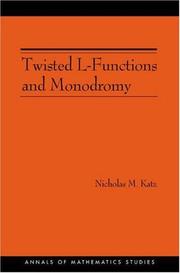
ISBN: 1282820893 9786612820892 1400824885 069109151X 0691091501 9781400824885 9780691091501 9780691091518 9781282820890 6612820896 Year: 2009 Volume: 150 Publisher: Princeton, NJ
Abstract | Keywords | Export | Availability | Bookmark
 Loading...
Loading...Choose an application
- Reference Manager
- EndNote
- RefWorks (Direct export to RefWorks)
For hundreds of years, the study of elliptic curves has played a central role in mathematics. The past century in particular has seen huge progress in this study, from Mordell's theorem in 1922 to the work of Wiles and Taylor-Wiles in 1994. Nonetheless, there remain many fundamental questions where we do not even know what sort of answers to expect. This book explores two of them: What is the average rank of elliptic curves, and how does the rank vary in various kinds of families of elliptic curves? Nicholas Katz answers these questions for families of ''big'' twists of elliptic curves in the function field case (with a growing constant field). The monodromy-theoretic methods he develops turn out to apply, still in the function field case, equally well to families of big twists of objects of all sorts, not just to elliptic curves. The leisurely, lucid introduction gives the reader a clear picture of what is known and what is unknown at present, and situates the problems solved in this book within the broader context of the overall study of elliptic curves. The book's technical core makes use of, and explains, various advanced topics ranging from recent results in finite group theory to the machinery of l-adic cohomology and monodromy. Twisted L-Functions and Monodromy is essential reading for anyone interested in number theory and algebraic geometry.
L-functions. --- Monodromy groups. --- Functions, L --- -L-functions. --- Group theory --- -Number theory --- L-functions --- Monodromy groups --- Abelian variety. --- Absolute continuity. --- Addition. --- Affine space. --- Algebraically closed field. --- Ambient space. --- Average. --- Betti number. --- Birch and Swinnerton-Dyer conjecture. --- Blowing up. --- Codimension. --- Coefficient. --- Computation. --- Conjecture. --- Conjugacy class. --- Convolution. --- Critical value. --- Differential geometry of surfaces. --- Dimension (vector space). --- Dimension. --- Direct sum. --- Divisor (algebraic geometry). --- Divisor. --- Eigenvalues and eigenvectors. --- Elliptic curve. --- Equation. --- Equidistribution theorem. --- Existential quantification. --- Factorization. --- Finite field. --- Finite group. --- Finite set. --- Flat map. --- Fourier transform. --- Function field. --- Functional equation. --- Goursat's lemma. --- Ground field. --- Group representation. --- Hyperplane. --- Hypersurface. --- Integer matrix. --- Integer. --- Irreducible component. --- Irreducible polynomial. --- Irreducible representation. --- J-invariant. --- K3 surface. --- L-function. --- Lebesgue measure. --- Lefschetz pencil. --- Level of measurement. --- Lie algebra. --- Limit superior and limit inferior. --- Minimal polynomial (field theory). --- Modular form. --- Monodromy. --- Morphism. --- Numerical analysis. --- Orthogonal group. --- Percentage. --- Polynomial. --- Prime number. --- Probability measure. --- Quadratic function. --- Quantity. --- Quotient space (topology). --- Representation theory. --- Residue field. --- Riemann hypothesis. --- Root of unity. --- Scalar (physics). --- Set (mathematics). --- Sheaf (mathematics). --- Subgroup. --- Summation. --- Symmetric group. --- System of imprimitivity. --- Theorem. --- Trivial representation. --- Zariski topology.
Book
ISBN: 1283379961 9786613379962 1400842700 9781400842704 9781283379960 9780691153308 9780691153315 0691153302 0691153310 Year: 2012 Publisher: Princeton, NJ
Abstract | Keywords | Export | Availability | Bookmark
 Loading...
Loading...Choose an application
- Reference Manager
- EndNote
- RefWorks (Direct export to RefWorks)
Convolution and Equidistribution explores an important aspect of number theory--the theory of exponential sums over finite fields and their Mellin transforms--from a new, categorical point of view. The book presents fundamentally important results and a plethora of examples, opening up new directions in the subject. The finite-field Mellin transform (of a function on the multiplicative group of a finite field) is defined by summing that function against variable multiplicative characters. The basic question considered in the book is how the values of the Mellin transform are distributed (in a probabilistic sense), in cases where the input function is suitably algebro-geometric. This question is answered by the book's main theorem, using a mixture of geometric, categorical, and group-theoretic methods. By providing a new framework for studying Mellin transforms over finite fields, this book opens up a new way for researchers to further explore the subject.
Mellin transform. --- Convolutions (Mathematics) --- Sequences (Mathematics) --- Mathematical sequences --- Numerical sequences --- Algebra --- Mathematics --- Convolution transforms --- Transformations, Convolution --- Distribution (Probability theory) --- Functions --- Integrals --- Transformations (Mathematics) --- Transform, Mellin --- Integral transforms --- ArtinГchreier reduced polynomial. --- Emanuel Kowalski. --- EulerАoincar formula. --- Frobenius conjugacy class. --- Frobenius conjugacy. --- Frobenius tori. --- GoursatЋolchinВibet theorem. --- Kloosterman sheaf. --- Laurent polynomial. --- Legendre. --- Pierre Deligne. --- Ron Evans. --- Tannakian category. --- Tannakian groups. --- Zeeev Rudnick. --- algebro-geometric. --- autodual objects. --- autoduality. --- characteristic two. --- connectedness. --- dimensional objects. --- duality. --- equidistribution. --- exponential sums. --- fiber functor. --- finite field Mellin transform. --- finite field. --- finite fields. --- geometrical irreducibility. --- group scheme. --- hypergeometric sheaf. --- interger monic polynomials. --- isogenies. --- lie-irreducibility. --- lisse. --- middle convolution. --- middle extension sheaf. --- monic polynomial. --- monodromy groups. --- noetherian connected scheme. --- nonsplit form. --- nontrivial additive character. --- number theory. --- odd characteristic. --- odd prime. --- orthogonal case. --- perverse sheaves. --- polynomials. --- pure weight. --- semisimple object. --- semisimple. --- sheaves. --- signs. --- split form. --- supermorse. --- theorem. --- theorems.
| Listing 1 - 10 of 12 | << page >> |
Sort by
|

 Search
Search Feedback
Feedback About UniCat
About UniCat  Help
Help News
News